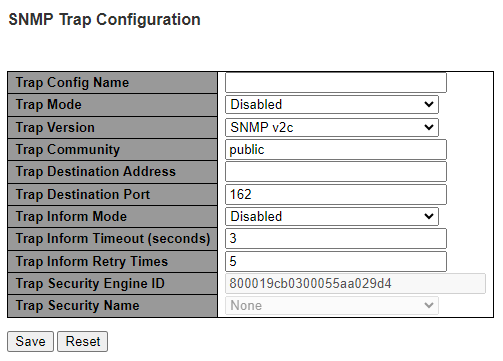4.1.3.2.1 SNMP-Trap Destinations-Configuration
The following figure shows the Trap Destinations Configuration page.

The Trap Destinations Configuration page has the following parameters:
- Trap Config Name: Indicates the trap Configuration's name for configuring. The allowed string length is 1 to 32, and the allowed content is ASCII characters from 33 to 126.
- Trap Mode: Enable/disable from traps that are sent by the unit
- Trap Version: Indicates the SNMP supported version. Possible versions are: SNMPv1, SNMPv2c, and SNMPv3.
- Trap Community: Indicates the community access string when sending SNMP trap packet. The allowed string length is 0 to 63, and the allowed content is ASCII characters from 33 to 126.
- Trap Destination Address: Indicates the SNMP trap destination address. It allows a valid IP address in dotted decimal notation ('x.y.z.w'). And it also allow a valid hostname. A valid hostname is a string drawn from the alphabet (A-Za-z), digits (0-9), dot (.), dash (-). Spaces are not allowed, the first character must be an alpha character, and the first and last characters must not be a dot or a dash. Indicates the SNMP trap destination IPv6 address. IPv6 address is in 128-bit records represented as eight fields of up to four hexadecimal digits with a colon separating each field (:). For example, 'fe80::215:c5ff:fe03:4dc7'. The symbol '::' is a special syntax that can be used as a shorthand way of representing multiple 16-bit groups of contiguous zeros; but it can appear only once. It can also represent a legally valid IPv4 address. For example, '::192.1.2.34'.
- Trap Destination Port: Indicates the SNMP trap destination port. SNMP Agent sends the SNMP message via this port; the port range is 1–65535.
- Trap Inform Mode: Indicates the SNMP trap inform mode operation. Possible modes are: Enabled/Disabled.
- Trap Inform Timeout (seconds): Indicates the SNMP trap inform timeout. The allowed range is 0 to 2147.
- Trap Inform Retry Times: Indicates the SNMP trap inform retry times. The allowed range is 0 to 255.
- Trap Security Engine ID: Indicates the SNMPv3 trap security engine ID. SNMPv3 sends traps and informs using USM for authentication and privacy. A unique engine ID for these traps and informs is needed. The string must contain an even number (in hexadecimal format) with number of digits between 10 and 64, but all-zeros and all-'F's are not allowed.
- Trap Security Name: Indicates the SNMP trap security name. SNMPv3 traps and informs using USM for authentication and privacy. A unique security name is needed when traps and informs are enabled.
